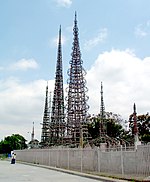The Barrelhouse
African-American musicMusic venues completed in 1948Music venues in Los AngelesNightclubs in Los Angeles County, CaliforniaWatts, Los Angeles
The Barrelhouse Club, at 107th and Wilmington in Watts, Los Angeles, was a rhythm and blues nightclub opened in 1948 and co-owned by Johnny Otis, and Bardu and Tila Ali.It was named in honour of the Barrel House in Omaha, Nebraska, the first club in that district to welcome black and white customers.
Excerpt from the Wikipedia article The Barrelhouse (License: CC BY-SA 3.0, Authors).The Barrelhouse
Wilmington Avenue, Los Angeles Watts
Geographical coordinates (GPS) Address Nearby Places Show on map
Geographical coordinates (GPS)
| Latitude | Longitude |
|---|---|
| N 33.939009 ° | E -118.239076 ° |
Address
Wilmington Avenue 10699
90002 Los Angeles, Watts
California, United States
Open on Google Maps







